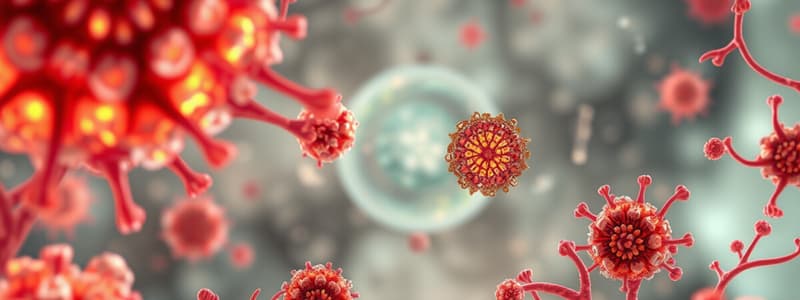Podcast
Questions and Answers
What is a key feature that distinguishes prokaryotic cells from eukaryotic cells?
What is a key feature that distinguishes prokaryotic cells from eukaryotic cells?
- Membrane-bound nucleus (correct)
- Presence of a cell wall
- Circular DNA structure (correct)
- Multiple chromosomes
Which of the following organelles is NOT found in prokaryotic cells?
Which of the following organelles is NOT found in prokaryotic cells?
- Nucleoid
- Cell membrane
- Mitochondria (correct)
- Ribosomes
Which process is associated with cell division in prokaryotic cells?
Which process is associated with cell division in prokaryotic cells?
- Meiosis
- Binary fission (correct)
- Budding
- Mitosis
What function does the Golgi apparatus serve in eukaryotic cells?
What function does the Golgi apparatus serve in eukaryotic cells?
What is the approximate size range of prokaryotic cells?
What is the approximate size range of prokaryotic cells?
Which component of eukaryotic cells is responsible for photosynthesis?
Which component of eukaryotic cells is responsible for photosynthesis?
Which structure provides structural support in prokaryotic cells?
Which structure provides structural support in prokaryotic cells?
Which of the following statements correctly describes eukaryotic cells?
Which of the following statements correctly describes eukaryotic cells?
Flashcards are hidden until you start studying
Study Notes
Prokaryotic Cells
-
Simpler and smaller compared to eukaryotic cells.
-
Primarily found in single-celled organisms such as bacteria.
-
Key Characteristics:
- Lack a membrane-bound nucleus; DNA is located in the nucleoid region.
- Absence of membrane-bound organelles.
- Size typically ranges from 0.1 to 5.0 μm in diameter.
-
Primary Functions of Components:
- Cell Membrane: Regulates the movement of substances in and out of the cell.
- Cytoplasm: Hosts metabolic reactions necessary for cell survival.
- Nucleoid: Area where the cell's DNA is situated.
- Ribosomes: Responsible for protein synthesis.
- Cell Wall: Offers structural support and protection against environmental stresses.
- Flagella (present in some): Facilitate movement and locomotion of the cell.
Eukaryotic Cells
-
More complex and generally larger than prokaryotic cells.
-
Found in multicellular organisms, including plants, animals, fungi, and protists.
-
Key Characteristics:
- Possess a membrane-bound nucleus that encloses DNA.
- Contain various membrane-bound organelles.
- Size typically ranges from 10 to 100 μm in diameter.
-
Primary Functions of Components:
- Nucleus: Directs cell activities and protein synthesis by housing DNA.
- Mitochondria: Generate ATP through cellular respiration, serving as the powerhouses of the cell.
- Endoplasmic Reticulum: Modifies proteins and synthesizes lipids for cellular functions.
- Golgi Apparatus: Modifies, sorts, and packages proteins for secretion or use within the cell.
- Lysosomes: Break down macromolecules and recycle damaged organelles.
- Chloroplasts (in plants): Conduct photosynthesis to convert sunlight into energy.
- Vacuoles: Store and transport various substances within the cell.
Key Differences Between Prokaryotic and Eukaryotic Cells
-
Nucleus: Prokaryotes do not have a membrane-bound nucleus; eukaryotes do.
-
Organelles: Prokaryotes lack membrane-bound organelles, while eukaryotes possess a variety of organelles.
-
Size: Prokaryotic cells are generally smaller than their eukaryotic counterparts.
-
DNA Arrangement: Prokaryotic DNA is circular and localized in the nucleoid; eukaryotic DNA is linear and contained within the nucleus.
-
Cell Division: Prokaryotes reproduce via binary fission, while eukaryotes utilize mitosis or meiosis for cell division.
-
Complexity: Eukaryotic cells exhibit greater complexity in both structure and function compared to prokaryotic cells.
-
Both cell types share fundamental components such as cell membrane, cytoplasm, and ribosomes, but their structural differences highlight distinct functions and evolutionary adaptations.
Studying That Suits You
Use AI to generate personalized quizzes and flashcards to suit your learning preferences.




